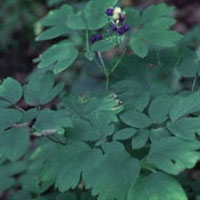Gluten Free
What does following a gluten-free diet mean? That you're embarking on an easy diet with a wide range of health-promoting effects. Instead of dwelling on what you’re giving up, consider that you’re going to enjoy a whole new world of delicious food options to meet your special dietary needs. You’ll be eating seasonally, choosing more fresh fruits and vegetables, focusing on meats, seafood, poultry, legumes, lentils, corn, and rice, and discovering fascinating ancient grains such as quinoa, amaranth, and millet. You’ll be able to eat potatoes, eggs, most cheeses, even chocolate (!)—and enjoy them without guilt because you’ll be taking good care of your body. In fact, you’ll probably end up eating—and feeling—better than ever!
Visit this page for more information about living Gluten Free
---
We carry a large variety of gluten free items, the brands listed below represent just some of the offerings we carry















More Diets
Blue Cohosh
 © Steven Foster
© Steven FosterParts Used & Where Grown
Blue cohosh grows throughout North America. The roots of this flower are used medicinally. Blue cohosh is not related to black cohosh (Cimicifuga racemosa). However, both herbs are primarily used to treat women’s health problems.
- Reliable and relatively consistent scientific data showing a substantial health benefit.
- Contradictory, insufficient, or preliminary studies suggesting a health benefit or minimal health benefit.
- For an herb, supported by traditional use but minimal or no scientific evidence. For a supplement, little scientific support.
Our proprietary “Star-Rating” system was developed to help you easily understand the amount of scientific support behind each supplement in relation to a specific health condition. While there is no way to predict whether a vitamin, mineral, or herb will successfully treat or prevent associated health conditions, our unique ratings tell you how well these supplements are understood by the medical community, and whether studies have found them to be effective for other people.
For over a decade, our team has combed through thousands of research articles published in reputable journals. To help you make educated decisions, and to better understand controversial or confusing supplements, our medical experts have digested the science into these three easy-to-follow ratings. We hope this provides you with a helpful resource to make informed decisions towards your health and well-being.
This supplement has been used in connection with the following health conditions:
| Used for | Amount | Why |
|---|---|---|
Amenorrhea | Refer to label instructions | Traditional practitioners consider blue cohosh to be a uterine tonic and an agent that stimulates menstrual blood flow, and it is used as a remedy for lack of menstruation.
|
Dysmenorrhea | Refer to label instructions | Blue cohosh has been used traditionally for easing painful menstrual periods. Women of childbearing age using this herb should stop using it as soon as they become pregnant. |
Traditional Use (May Not Be Supported by Scientific Studies)
Native Americans are believed to have used blue cohosh flowers to induce labor and menstruation.1 Blue cohosh is a traditional remedy for lack of menstruation. It is considered an emmenagogue (agent that stimulates menstrual flow) and a uterine tonic. No clinical trials have validated this traditional use. It has also been used traditionally to treat painful periods (dysmenorrhea). Early 20th century physicians in the United States who treated with natural remedies (known as Eclectic physicians) used blue cohosh for these same purposes and also to treat kidney infections, arthritis, and other ailments.
Copyright © 2025 TraceGains, Inc. All rights reserved.
Learn more about TraceGains, the company.
The information presented by TraceGains is for informational purposes only. It is based on scientific studies (human, animal, or in vitro), clinical experience, or traditional usage as cited in each article. The results reported may not necessarily occur in all individuals. Self-treatment is not recommended for life-threatening conditions that require medical treatment under a doctor's care. For many of the conditions discussed, treatment with prescription or over the counter medication is also available. Consult your doctor, practitioner, and/or pharmacist for any health problem and before using any supplements or before making any changes in prescribed medications. Information expires December 2025.











